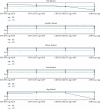An Ensemble Learning Method Based on an Evidential Reasoning Rule considering Combination Weighting
- PMID: 35295274
- PMCID: PMC8920696
- DOI: 10.1155/2022/1156748
An Ensemble Learning Method Based on an Evidential Reasoning Rule considering Combination Weighting
Abstract
As an extension of Dempster-Shafer (D-S) theory, the evidential reasoning (ER) rule can be used as a combination strategy in ensemble learning to deeply mine classifier information through decision-making reasoning. The weight of evidence is an important parameter in the ER rule, which has a significant effect on the result of ensemble learning. However, current research results on the weight of evidence are not ideal, leveraging expert knowledge to assign weights leads to the excessive subjectivity, and using sample statistical methods to assign weights relies too heavily on the samples, so the determined weights sometimes differ greatly from the actual importance of the attributes. Therefore, to solve the problem of excessive subjectivity and objectivity of the weights of evidence, and further improve the accuracy of ensemble learning based on the ER rule, we propose a novel combination weighting method to determine the weight of evidence. The combined weights are calculated by leveraging our proposed method to combine subjective and objective weights of evidence. The regularization of these weights is studied. Then, the evidential reasoning rule is used to integrate different classifiers. Five case studies of image classification datasets have been conducted to demonstrate the effectiveness of the combination weighting method.
Copyright © 2022 Cong Xu et al.
Conflict of interest statement
The authors declare that they have no conflicts of interest.
Figures









Similar articles
-
Bearing Fault Diagnosis Based on a Hybrid Classifier Ensemble Approach and the Improved Dempster-Shafer Theory.Sensors (Basel). 2019 May 6;19(9):2097. doi: 10.3390/s19092097. Sensors (Basel). 2019. PMID: 31064125 Free PMC article.
-
Spammer detection using multi-classifier information fusion based on evidential reasoning rule.Sci Rep. 2022 Jul 21;12(1):12458. doi: 10.1038/s41598-022-16576-7. Sci Rep. 2022. PMID: 35864136 Free PMC article.
-
A New Reliability Coefficient Using Betting Commitment Evidence Distance in Dempster-Shafer Evidence Theory for Uncertain Information Fusion.Entropy (Basel). 2023 Mar 6;25(3):462. doi: 10.3390/e25030462. Entropy (Basel). 2023. PMID: 36981350 Free PMC article.
-
A mapping study of ensemble classification methods in lung cancer decision support systems.Med Biol Eng Comput. 2020 Oct;58(10):2177-2193. doi: 10.1007/s11517-020-02223-8. Epub 2020 Jul 3. Med Biol Eng Comput. 2020. PMID: 32621068 Review.
-
Reviewing ensemble classification methods in breast cancer.Comput Methods Programs Biomed. 2019 Aug;177:89-112. doi: 10.1016/j.cmpb.2019.05.019. Epub 2019 May 20. Comput Methods Programs Biomed. 2019. PMID: 31319964 Review.
Cited by
-
Dynamic Evaluation of Transformation Ability for Emergency Scientific Research Achievements Based on an Improved Minimum Distance-Maximum Entropy Combination Weighting Method: A Case Study of COVID-19 Epidemic Data.Comput Intell Neurosci. 2022 Aug 12;2022:8005249. doi: 10.1155/2022/8005249. eCollection 2022. Comput Intell Neurosci. 2022. PMID: 35990119 Free PMC article.
References
-
- Yang J.-B., Xu D.-L. Evidential reasoning rule for evidence combination. Artificial Intelligence . 2013;205(1):1–29. doi: 10.1016/j.artint.2013.09.003. - DOI
-
- Tian Q.-Y., Wei J.-H., Fang J.-H., Guo K. Adaptive fuzzy integral sliding mode pressure control for cutter feeding system of trench cutter. Journal of Central South University . 2016;23(12):3302–3311. doi: 10.1007/s11771-016-3396-2. - DOI
-
- Kong G., Xu D.-L., Yang J.-B., Ma X. Combined medical quality assessment using the evidential reasoning approach. Expert Systems with Applications . 2015;42(13):5522–5530. doi: 10.1016/j.eswa.2015.03.009. - DOI
MeSH terms
LinkOut - more resources
Full Text Sources
Research Materials

